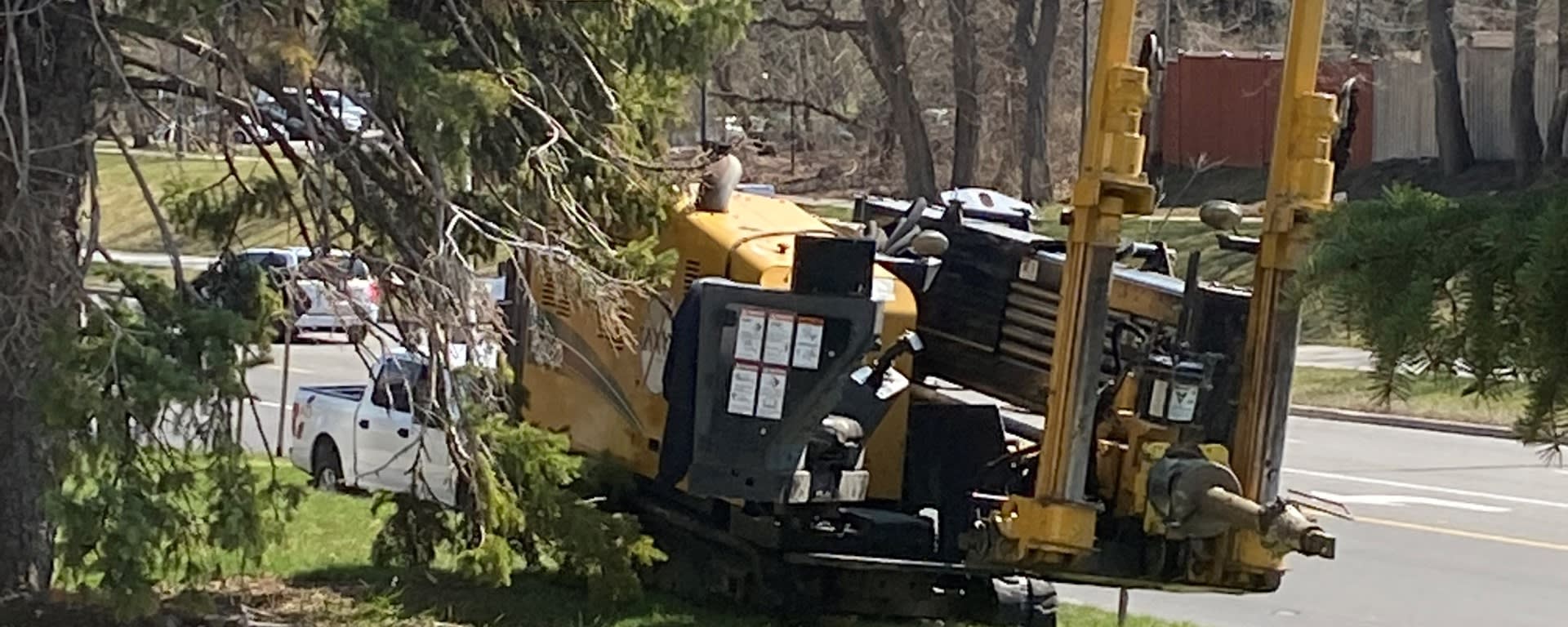A first step for new ECWE stations at Kipling and Martin Grove
Workers are on the ground for the Eglinton Crosstown West Extension through Etobicoke & Mississauga.
Apr 13, 2021
Crews can already be seen along Eglinton Ave West performing early works of site surveys, geotechnical site investigations and utilities relocations for the Eglinton Crosstown West Extension.
Telecommunications companies must relocate underground fibre optic cables out of the way of four future landmarks along the route.
Crews haves already finished working in boulevards along Eglinton Avenue West at Martin Grove Road, Kipling Avenue, Royal York Road and Scarlett Road, which will be station sites.
More work will follow to prepare for the launch shaft and portal west of Scarlett Road, and an emergency exit near the intersection of Russell Road and Eden Valley Drive.
Additional crews will relocate telecommunications lines at the Martin Grove site in late April or early May.
This work crew is using a direction drilling technique to move fibre optics cables for Rogers Communications along Eglinton Avenue West at Martin Grove Road, the future site of a station on the Eglinton Crosstown West Extension. Working in the boulevard minimizes the impact on traffic. (Metrolinx photo)
Moving these telecommunications lines is an early priority for the project.
“It’s been clear that these were going to be in the way, so we are fast-tracking the work,” said Chris Phillips, Project Director for the Eglinton Crosstown West Extension.
Utility lines must be moved in the early days of any subway project before headwalls – vertical columns of concrete – are built by a contractor at both ends of a new subway station.
“As part of the early works that must be completed in advance of the tunnel boring, these vertical walls are built underground,” Phillips said. “Then, the tunnel will be drilled through the two walls and a contractor will dig out the stations between the walls, which will serve as its bookends.”
Infrastructure Ontario recently announced that West End Connectors have been identified to design, build and finance tunnels for the Eglinton Crosstown West Extension, with the contract expected to be closed this spring.
Taking care of utility locations at this stage ensures it will not cause a delay once construction starts working along the route.
Often subway projects involve moving several different types of utilities – including gas, water, hydro, cable, and other lines – but it`s less of an issue for this extension.
“Our engineers found the best tunnel alignment and there are very few locations where utilities have to be moved,” said Nasir Qureshi, Senior Project Manager.
Telecommunications companies are moving these phone lines using a technique called horizontal directional drilling. The drilling starts from the surface, or a shallow pit, and it proceeds underground, with crews working with rigs on the boulevards (between the curb and the sidewalk) staying out of the way of traffic.
Directional drilling along Eglinton Avenue takes advantage of open space to keep equipment off the street. Sidewalks may occasionally be blocked, but there is still room to walk safely. (Metrolinx photo)
“The lines are laid about one metre below ground, so the entry pits are fairly shallow,” Qureshi said.
The telecommunications lines will be encased in flexible, bright orange, 100-mm high-density polyethylene conduit.
This technique is used to lay underground pipes along a length of up to 400 m in one drill shot.
The work crews use tracking technology to monitor the underground drilling path.
“We can track the path and make sure it’s going in at exactly the same depth and alignment that it’s designed for,” Qureshi said.
After the lines are laid, a pullback at the other end will remove the drill tip and utility coil pipe at the other end.
“You drill through, attach the pipe at the other end and then pull that pipe back through that hole that you made underground,” Phillips said.
Horizontal directional drilling is a huge improvement over the older way of moving utilities, which involved digging a long trench, laying conduits, pouring and curing concrete, pulling cables through, filling the trench back up, and then restoring the road and ground conditions.
Over the past few decades, the directional drilling technique has been successfully used by the local Toronto area contractors for installation of underground pipes.
by Mike Winterburn Metrolinx communications senior advisor
